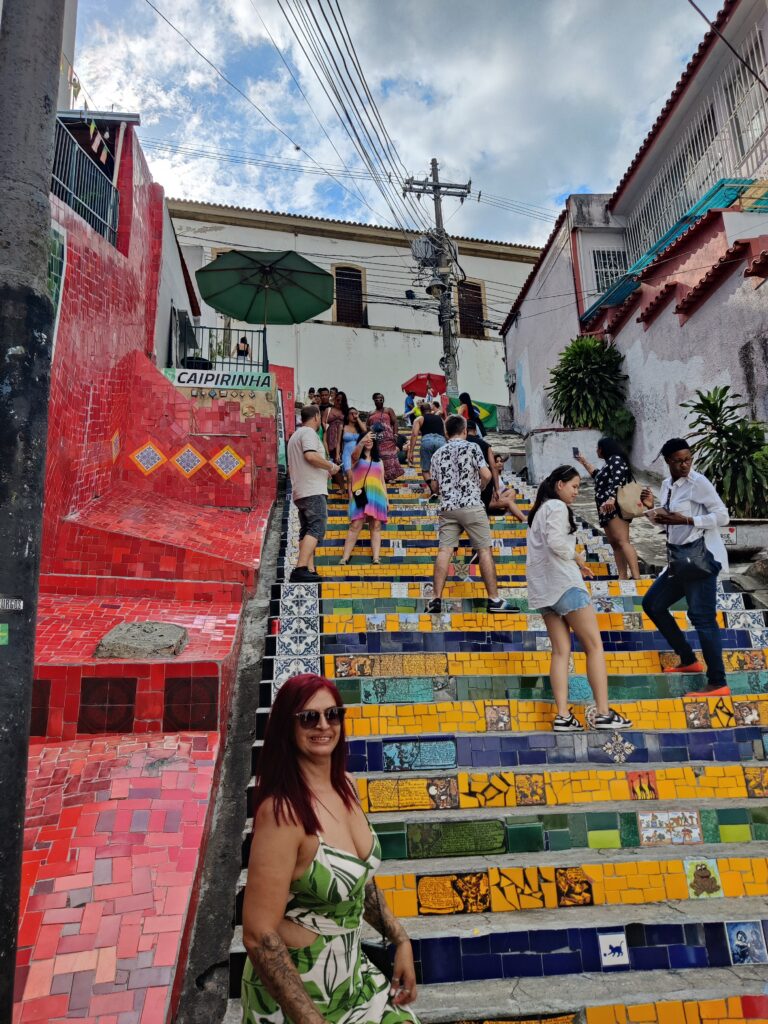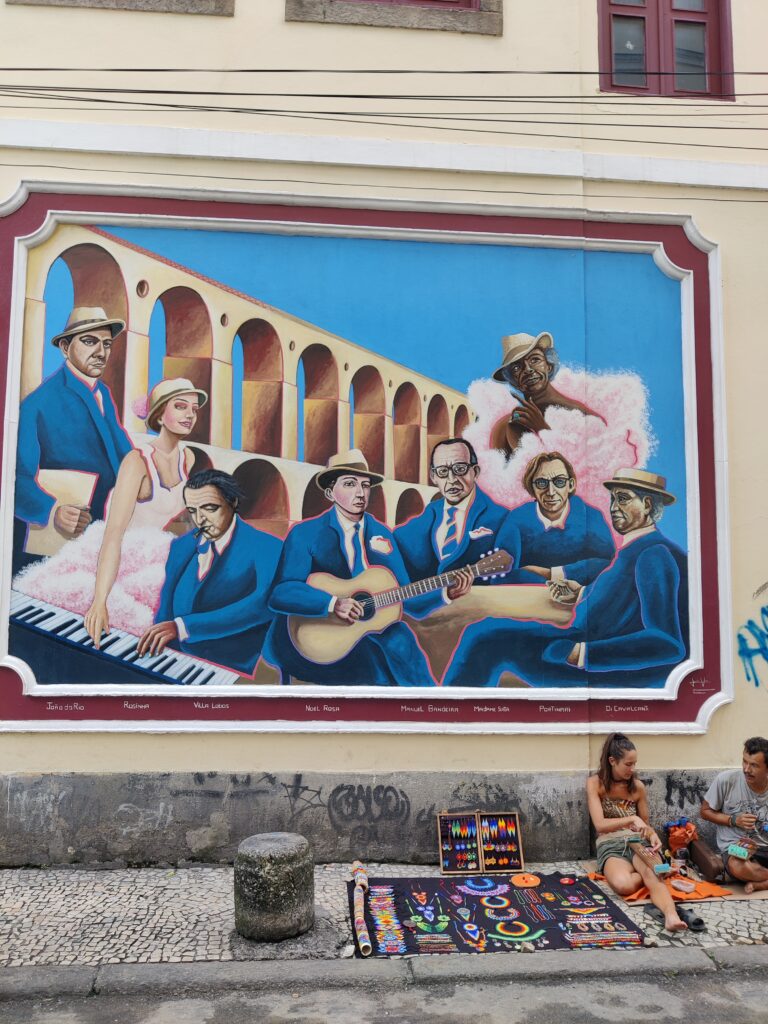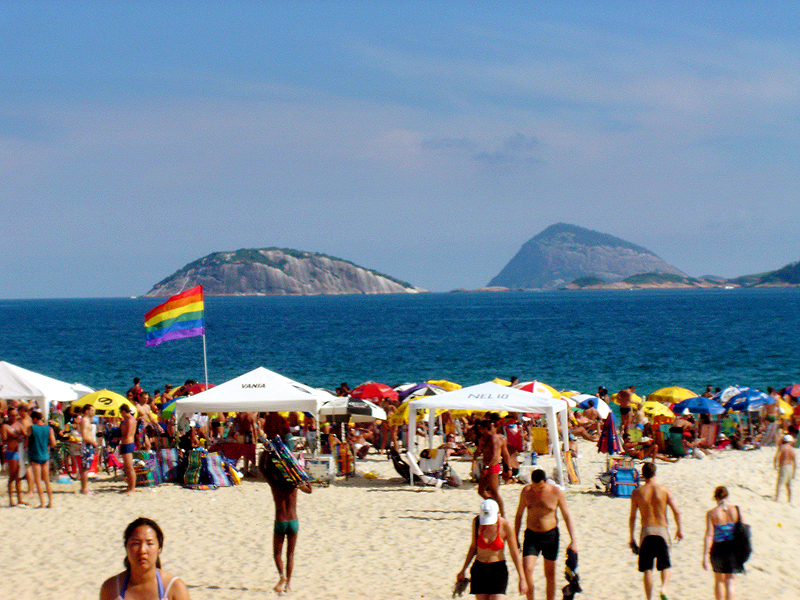Each of the world’s great cities has their own brand, and the brand of Rio de Janeiro, Brazil, is composed of four elements: sand, sun, sexiness and samba (especially at its famous Carnaval).
Sand and sun are especially important. While residents of other cities are constantly in search of the next hot restaurant, bar or nightclub to live the good life and find their tribe, cariocas (the name for the residents of Rio) strip down to their sungas and tangas and head for the beach. That’s what visitors tend to do, too. For some travellers, LGBTQ+ Rio equals Ipanema—period. That’s a shame, because the Cidade Maravilhosa, which has a metro population of 13.6 million, is awash in culture and nature for those visitors who go looking for it. Even the downtown, which a couple of decades ago was worth avoiding, is alive with history, culture and clubs, especially the neighbourhood of Saúde, where a seedy waterfront has been transformed into an entertainment district.
Many of the things visitors loves about Rio—middle-class beachside neighbourhoods like Copacabana, the cable car ride up Sugarloaf, the regal architecture of the Cinelândia theatre district, the musical genre of samba—were created or perfected during the city’s Belle Epoque era from 1898 to 1914. Though the city has a history going back to 1565, that’s the era when Rio was reinvented as a modern global metropolis. Perhaps not coincidentally, that’s also when Rio’s modern gay subculture first emerged; in the early 20th century, certain streets and parks on the edge of downtown became known places where men could find sex and friendship among likewise-inclined men.
The city has been pretty damn gay ever since.
Sweeping stereotypes about groups of people are unfair. But cariocas are good sports, so I’ll do it anyway. Unlike the inhabitants of Rio’s rival city, São Paulo (read our insider’s guide to SP here), where the LGBTQ+ community has a more edgy, “queer” and politicized vibe (note SP’s huge Pride celebrations), LGBTQ+ cariocas (and there are a lot of them) tend to have more traditional attitudes about gender; their politics are less strident. Perhaps the extreme straightness of “The Girl from Ipanema” did something to their brains. As well, the state of Rio de Janeiro has a reputation of being more politically conservative and uptight than outsiders would think after seeing all the skin that’s on display at the beach.
Inhibitions go out the window during Carnaval, which next takes place February 28 to March 5, 2025 (it moves around according to the Roman Catholic calendar). During Carnaval, taboos about gender expression, sexual experimentation and overt displays of sexuality go out the window. Though tickets are pricey for the main Carnaval event, where 14 elite samba “schools” stage elaborate parades in the Sambadrome, visitors on a tighter budget can join in neighbourhood bloco parades. The Banda de Ipanema bloco, a tradition since 1965, takes place three times during Carnaval season and is by far the gayest bloco to jump into.
In its laws and policies, Brazil is one of the most progressive countries in the world for LGBTQ+ people. Same-sex marriage was legalized in 2013 and discrimination against LGBTQ+ people has, since 2019, been considered a “crime of racism”—it’s prohibited nationally. Conversion therapy is banned and gender-affirming care is legal and available, though nonbinary gender recognition applies only to intersex people. Like in other countries, the application of these policies differs from region to region, circumstance to circumstance.
The same goes for crime. Brazil’s crime rates are higher than in North America and Europe, but people who are socially disadvantaged, particularly Brazilian trans women, bear the brunt of this. For visitors, common-sense strategies reduce risks: carry little of value when out and about, stick to areas where there are lots of people around, and use ride-share services at night and when going to less affluent and less familiar areas. You can use a card at the end of the day to pay beach vendors for drinks, food and the rental of chairs and umbrellas, so usually there’s no need to take anything to the beach other than your body, what you’re wearing and a single form of payment. When in doubt, look around to see what the locals are doing.
Although Rio’s beaches are big and beautiful—you’re obviously going to want a sunset selfie on Ipanema with Morro Dois Irmãos in the background—its beach culture is just as fascinating. Different numbered sections of Leme, Copacabana, Ipanema and Leblon beaches are dominated by different subcultures. Posto 8 in Ipanema is mellow and child-friendly, and there are beach volleyball courts near Posto 10. Around Ipanema’s Posto 9, at the bottom of Rua Farme de Amoedo, it gets more crowded, and it’s hard to ignore the buff men there, many of them in skimpy and brightly coloured sungas, and the club promoters handing out flyers for a gay party that night or that weekend. Though there are rainbow flags marking this area, there are also various rainbow flags along Rio’s beaches, so don’t get confused. When the man meat is at its densest, you’ll know you’re at ground zero.

Rua Farme de Amoedo and Rua Teixeira de Melo in Ipanema, though not as in your face as São Paulo’s Frei Caneca, can be considered Rio’s main gay streets. After the sun goes down, a segment of the Posto 9 crowd will stroll up these streets, still in their bathing suits, for drinks at Bar Popeye (R. Visconde de Pirajá 181, Ipanema, Rio de Janeiro) and other watering holes along Ipanema’s main drag, Rua Visconde de Pirajá. What happens next depends on who a visitor has encountered during the day, but dancing and flirting are possibilities.
Though the beaches get all the attention, Rio has lots to offer those who are sand adverse. Most cultural institutions and museums are in or near the city centre, as is the city’s biggest gay dance club, the Home (formerly known as the Week). The Line 4 subway of Rio’s metro system connects the beach neighbourhoods to the centre, making it the cheapest and often quickest way to shuttle between the areas where most visitors stay and where many of the capital-A attractions are.
The hilltop bohemian neighbourhood of Santa Teresa, which can be reached by old-school trams, is a great place to brush shoulders with artsy types. Those green mountains that are in the background of all your pictures? That’s mostly Parque Nacional da Tijuca, a huge tropical jungle preserve that can be visited independently or with a tour operator.
Visitors with more time can head across the bay to Niterói, a suburb with quieter beaches and a museum of contemporary art (Mirante da Boa Viagem s/n, Boa Viagem, Niterói) designed by Brazilian architectural god Oscar Niemeyer. Add another day or two for a drive or bus down the coast to the historic-but-chic town of Paraty, which is known for being especially LGBTQ+ friendly, or up the coast to the ritzier resort area of Búzios.
However much time you book for your visit to Rio, you’re going to think it’s not enough, even if you’re spending all day every day at Posto 9.
What to see and do
Rio Pride/Parada do Orgulho LGBTI (November 24, 2024). Though not as big and famous as São Paulo’s Pride festival, Rio’s is a lot of fun and includes performances and parties, as well as protests. It’s often outshone, even for LGBTQ+ people, by Carnaval (see below) and Rio’s massive New Year’s celebrations, which involve millions of people partying on Copacabana Beach dressed all in white.
Beaches. Much of Rio’s gay life (but not the big clubs) is walking distance from Posto 9 in Ipanema. Rent a chair and umbrella, have a few beers and some snacks here, applaud the sunset over Dois Irmãos mountains, and you’ve got yourself a brilliant vacation. Arpoador is the small area linking Ipanema to Copacabana. Copacabana beach is bigger, busier and more accessible to locals than Ipanema; there are kiosks and affordable restaurants along its boulevard, between Postos 5 and 3, that make for a nice evening stroll. Rainbow Kiosk, in front of Copacabana Palace Hotel, used to be the “gay beach” before Posto 9 became more dominant. Leme, to a visitor, seems like just more of Copacabana. The next beach over, toward downtown, Botafogo, has poorer quality sand, while the next beach, Flamengo, is decent and definitely non-touristy. Going the other way, the next beach after Ipanema is Leblon, which is quieter than Ipanema and attracts a posher crowd. Further afield are the huge, chill beaches of the upper middle-class neighbourhood of Barra da Tijuca. For a frisky, clothing-optional gay beach, visitors will have to trek 43 kilometres south to Abricó Beach (Av. Estado da Guanabara, near Grumari), which is not accessible by public transit. Overt sexual displays on city beaches are frowned upon—yes, people may call you on it.

Aside from beaches, Rio has two flagship attractions that are so famous, you can probably name them before reaching the end of this sentence. The first is the Cristo Redentor statue that was inaugurated on the top of Corcovado mountain in 1931, one arm outstretched to the rich neighbourhoods, the other to the poor. The views are completely worth it, but prepare for a mob scene. Most visitors will take the steep tram up to the top from the tram station in the Cosme Velho neighbourhood, but there are many drivers, many of them of dubious character, who will offer to help visitors skip the tram lines by driving them up for a fee. The directions are not well marked so it’s tricky to navigate your way up on your own. Go as early as possible in the day to beat the cruise ship crowds. By mid afternoon, it can take a while to catch a train back down, so leave yourself plenty of time to exit.

The second flagship attraction is Pão de Açúcar, a rocky peak jutting out into the bay. It’s reached by two cable car rides from a station near Monumento aos Mortos na Intentona Comunista (rock climbing up is also possible). The rock, known in English as Sugarloaf, has spectacular views of the city, the bay and the ocean. The photo-op spots are more spread out than at Cristo Redentor, so there is less competition for the “perfect” shot, and there are restaurants and boutiques at both of the cable car stops, making it a more relaxed experience overall. Visit late enough in the day to catch the sunset over a cocktail at Clássico Beach Club at the Urca cable car stop.

Escadaria Selarón (R. Manuel Carneiro, Santa Teresa, Rio de Janeiro). As if Rio lacked must-do experiences, this stairway connecting the Lapa and Santa Teresa neighbourhoods has, in the last couple of decades, become another essential pilgrimage. Chilean-born artist Jorge Selarón started renovating the 215 dilapidated steps in 1990, covering them with thousands of blue, green and yellow tile fragments, some plain, some with art or illustration, some local, some donated from around the world. The project got more elaborate as it went on. Selarón was found dead on the steps in 2013, but others have added to the stairway, and the city is looking at what it needs to do to preserve and celebrate Selarón’s legacy. Nearby, on Rua Teotônio Regadas, on the side of Bar Ernesto, there’s a mural of early 20th-century Brazilian performers. Among them, in a blur of pink clouds, is Madame Satã, the artistic name of João Francisco dos Santos, a drag performer and self-declared outlaw who spent as much time in jail as they did onstage. The 2002 film Madame Satã, directed by Brazilian director Karim Aïnouz, tells the performer’s story.

Carnaval (February 28 to March 5, 2025). Carnaval traditions vary greatly across Brazil. Rio’s is a mix of hyper commercial and hyper local. Most famously, there is the famous parade competition, where 14 samba schools (a better word might be clubs, as in professional sports clubs) compete for cash prizes in the Sambadrome, a stadium built especially for Carnaval parades. Like a professional sports event, tickets are expensive and there are a lot of traditions and rules. For example, a school loses points if not every person in their parade is singing the song at all times during the procession. Additionally, various Rio neighbourhoods host bloco parades, where people march a route through the streets, singing and drinking and being silly, perhaps in costume but often not—anyone can join. The best bloco for LGBTQ+ visitors is Banda de Ipanema, which takes place three times during Carnaval season, winding through the streets of the beach neighbourhood. Dress as bare as you dare, but watch your wallet. Hotel prices go through the roof during Carnaval; visitors might have to book months in advance, and many properties will require four or more nights’ stay. Several ticketed gay circuit-style parties take place during Carnaval season.
Carnaval Experience (Entrada Principal, Avenida Binário do Porto, Cidade do Samba, Santo Cristo, Rio de Janeiro). If your visit to Rio isn’t timed to catch Carnaval, you can still get a glimpse of what it’s like. Depending on the time of year you visit, your guided tour of the warehouse and workshop complex of the samba school Acadêmicos do Grande Rio might, in the fall and winter, reveal floats and costumes being created for the upcoming samba parade or, in the spring, dismantled and recycled from the last. Really backstage stuff, including the opportunity to wear (and samba in) a Carnaval costume of your choice, regardless of gender.
Museu de Arte do Rio (Praça Mauá 5, Saúde, Rio de Janeiro). This is a museum whose spirit truly matches that of its home city, with big, bold and celebratory exhibits of contemporary art that are aimed to delight. Though the exhibits change regularly, there’s usually some queerness in the mix. Definitely worth a visit.
Museu do Amanhã (Praça Mauá 1, Centro, Rio de Janeiro). Inside this bug-like building designed by Spanish starchitect Santiago Calatrava are exhibits dedicated to science, technology and the future. It’s been a landmark on the waterfront since opening in 2015. The area around this museum and the Museu de Arte do Rio has been gentrifying over the last decade or so. While you’re here, take in some of the graffiti art and boutique shopping along Orla Prefeito Luiz Paulo Conde.
Museu de Arte Moderna do Rio de Janeiro (Av. Infante Dom Henrique 85, Parque do Flamengo, Rio de Janeiro). Closed for renovations until November 2024, this 1950s Modernist building designed by Affonso Eduardo Reidy usually displays art from the 20th century, as well as more contemporary work.
Parque Nacional da Tijuca. This 39-square kilometre tropical rainforest is part of the reason metropolitan Rio is broken up into disconnected neighbourhoods—the reserve’s mountainous green spaces reach out into the city like fingers. Those wishing to visit on their own should pick a monument or natural attraction in the park to head to—it’s too sprawling for unplanned meandering. Another option is to sign up for a tour with the likes of LGBTQ+-friendly Jeep Tour, which has been offering its rainforest tour since 1992.
Cinelândia. This Belle Epoque public square is home to some of Rio’s most beautiful buildings, including the Theatro Municipal, which was completed in 1909; Biblioteca Nacional, which was completed in 1810; and the Museu Nacional de Belas Artes (temporarily closed), completed in 1938. Though Rio has many hubs of interest, this is the city’s civic heart. There are bars and restaurants in the area, and it’s a key metro stop when coming downtown from the beach neighbourhoods. Not far away is the Catedral Metropolitana de São Sebastião do Rio de Janeiro (Av. República do Chile 245, Centro, Rio de Janeiro), a gigantic concrete cone of modernism, which opened in 1979. Whatever you think of it from the outside, or whatever you think of the Roman Catholic church, the interior lighting through the stained glass windows is astonishing. Across the street from the cathedral is the tram station to take a trolley to the Santa Teresa neighbourhood.
Santa Teresa. With its streets winding around and over the hills southwest of downtown, this artsy neighbourhood has a completely different vibe from anywhere else in Rio. You’ll see poets arguing about politics in bohemian cafés, spontaneous samba sessions breaking out on the street and queer hipsters quaffing pints of chopp (draft beer) at dive bars. There are other ways to get here than the tram (like walking up from Escadaria Selarón), but why wouldn’t you want to ride an antiquated tram on the bonde system, which opened in 1877?
Where to stay
Most visitors to Rio stay in the beach neighbourhoods of Copacabana, Arpoador, Ipanema and Leblon. The hotels in Ipanema and Leblon tend to be smaller scale, boutique-y and luxe; many budget-conscious travellers who want to be here end up in Airbnbs. Copacabana/Arpoador has a wider range of hotel sizes and price points, as well as a wider range of places to eat and shop. Choosing a property farther from the beach can save you money; it’s perfectly acceptable in these neighbourhoods to troop a few blocks to the beach in your bathing suit and flip-flops.
If the idea of visitors outnumbering locals turns you off, the beach neighbourhoods of Botafogo and Flamenco might be more appealing, though the choices of accommodations are more limited. For a stay whose main character is charm, there’s the hilltop neighbourhood of Santa Teresa, which has an array of small hotels and guest houses. Because the city centre can be eerily quiet at certain times of the day and on Sundays, it has fewer appealing accommodation options.
During Carnaval season, the cost of accommodations can go up dramatically, and many properties will require a four- or five-day booking. There’s no doing just a couple of days of Carnaval—if you’re coming, you’re paying to be all in.
JW Marriott (Av. Atlântica 2600, Copacabana, Rio de Janeiro). Across the street from Posto 4 at Copacabana Beach, this five-star LGBTQ+-friendly resort hotel is the perfect jumping-off point for gadding around the city, then coming back for cocktails by the rooftop pool while gazing out at the Atlantic Ocean. They’ve got a fitness centre and spa. The vibe is breezy resort with top-notch service.
Copacabana Palace, A Belmond Hotel (Av. Atlântica 1702, Copacabana, Rio de Janeiro). Rio’s most storied hotel, with a history dating back to 1923, has hosted stars like Marlene Dietrich, Brigitte Bardot, Madonna, Princess Diana, Carla Bruni, Halle Berry, Lana Del Rey and Miley Cyrus. Works as a pilgrimage site as well as a place to stay.
Hotel Fasano Rio de Janeiro (Av. Vieira Souto 80, Ipanema, Rio de Janeiro). Ipanema hotels right across from the beach are few and far between. Fortunately, one of them is this luxurious property by the Brazil-based Fasano Group. All the wood gives it a look that’s both mod and modern. There’s a rooftop pool if your room doesn’t have a beach-facing terrace.
Atlantis Copacabana Hotel (R. Bulhões Carvalho 61, Copacabana, Rio de Janeiro). Those struggling with the choice between chill Ipanema and bustling Copacabana should consider Arpoador, a small stretch that links the two. Though a little minimal in its décor, the Atlantis has an enviable location and great views from its rooftop pool.
Jo&Joe Rio (Beco do Boticário 26, Cosme Velho, Rio de Janeiro). Located in the neighbourhood of Cosme Velho, a few metres from Corcovado, this easygoing place to crash was recently voted the second-best hostel in the world, according to Hostelworld. A row of old houses was revitalized and given a modern style that contrasts with the historic structure—the solid wood ceiling in some rooms and the fountains in the garden give it real character. The hostel also has lots of space for leisure and mingling: three swimming pools, a restaurant, two bars, a games room, a co-working space and a space for events. There are 80 rooms, including both shared and private.
Che Lagarto (R. Barata Ribeiro 111, Copacabana, and Rua Paul Redfern 41, Ipanema, Rio de Janeiro). A nationwide chain of hostels (they’re also in Uruguay), these are modest places to stay with a party vibe. Both the Ipanema and Copacabana locations are located fewer than 250 metres from the beach—score. The Copacabana branch is in an old house with a lively bar at the entrance, so it’s not a place for those who are early to bed, early to rise.
Solar do Redentor Guesthouse (R. Cosme Velho, Casa 1451, Cosme Velho, Rio de Janeiro). This guest house and hostel, founded by a gay couple, is one of the rare accommodations in the city dedicated to an LGBTQ+ clientele. A large house with lots of greenery and views of Corcovado, there are six spacious rooms, a pool, a steam sauna, a BBQ area and other amenities. It’s close to the tram station that takes visitors up to see Cristo Redentor.
Where to eat
Cariocas love to grab quick bites at bakeries and lunch counters; Copacabana and Ipanema are full of places selling coxinha, pão de queijo, pastéls, sandwiches and freshly squeezed juices. They’re easy to find. We’ve picked some places that serve more substantial fare, several of which immerse visitors in carioca culture and history.
Churrascaria Palace (R. Rodolfo Dantas 16, Copacabana, Rio de Janeiro). You can kill two Brazilian experiences with one stone at this famed steakhouse. Firstly, there’s the rodízio service, where waitstaff bring various grilled meats to your table and shave off the pieces that catch your eye. (There’s a buffet with salad to supplement all that carnivore action.) Secondly, the restaurant, founded in 1951, was a haunt of many of the bossa nova music scene, many of whom are depicted on the giant mural in the front dining room. Popular on the tourist circuit, so it can get crowded. Though the stars and themes of the bossa nova musical movement are pretty straight, it’s worth knowing that the man considered to be the father of bossa nova, Johnny Alf, was Black and gay, and it’s said that racism and homophobia prevented him from being as well known as Antônio Carlos Jobim and the other bossa nova legends.
Confeitaria Colombo (R. Gonçalves Dias 32, Centro, Rio de Janeiro). Founded in 1894, this gorgeous two-storey art nouveau coffee house, with its stained-glass skylight, has been a haunt of Brazilian writers, artists and intellectuals for more than a century. The menu’s got everything from pastries to omelettes to pasta and sparkling wine—drop by no matter what you’re craving.
Restaurante e Bar Garota de Ipanema (R. Vinícius de Moraes 49, Ipanema, Rio de Janeiro). Legend has it that this was the place where the writers of “The Girl from Ipanema,” composer Antônio Carlos Jobim and the poet Vinícius de Moraes, saw the young woman who inspired the song. The restaurant, on a street now named after Moraes, is a great place to try classic Brazilian dishes like feijoada. Despite the touristy appeal, the prices are reasonable.
Sel d’Ipanema (Av. Vieira Souto, between Rua Garcia d’Avila and Rua Maria Quitéria, Ipanema, Rio de Janeiro). Most beachside restobars overly rely on their location more than their food and service, but this beach club has more style than most.
Suna Cozinha Asiática Artesanal (R. Francisco Otaviano 20, Copacabana, Rio de Janeiro). For a light meal among fashionable types bouncing between Ipanema and Copacabana, take a seat on the terrace and watch all the glorious cariocas go by. By Brazilian standards, the Asian cuisine is pretty authentic.
Restaurante Café Tero (Loja A, Ladeira Felipe Neri 11, Saúde, Rio de Janeiro). Cute bars and eateries are scattered on the narrow, hilly streets of this cute corner of downtown, just behind the Museum of Modern Art. This Italian-influenced place has a relaxed stay-all-day atmosphere, with jazz and tango event posters, as well as children’s drawings, covering some of its walls.
Where to party
Rio nightlife can range from enjoying convenience-store beer on the street with your new friends to resto-lounging past midnight to dancing at a megaclub until after the sun comes up. The gay venues here tend to lean more into music, with less drag than you’ll find in other large cities—though there is still drag to be found. Ticketed parties by promoters can happen anywhere—be prepared for a long Uber ride to Alto da Boa Vista or Barra da Tijuca for some mega-events. There are lots of mainstream open-air venues, mostly LGBTQ+-friendly, around the Arcos da Lapa in the Lapa neighbourhood.
At Brazilian nightclubs—that is, late-night dancefloor-dominant venues—you usually don’t pay for drinks as you go. You’ll be given a numbered wristband or card on arrival, and each order is noted on your bill. At the end of the night, you present your number to settle up with a cashier and obtain a receipt that allows you to leave the club. Even when clubs don’t have a cover charge, they might require a minimum drink consumption. If the consumption minimum is, say, 50 reals, and you only spend 10 on drinks, you’ll still have to pay 50 reals at the end of the night.
Bar Popeye (R. Visconde de Pirajá 181, Ipanema, Rio de Janeiro). We’re not suggesting you build your itinerary around this hole in the wall. But if you need a beer and a bite in that time of the day between the beach and a night out, a place to flirt and plan your next moves, the location, with its handful of tables on the sidewalk of Ipanema’s main drag, can’t be beat.
Galeria Café (R. Teixeira de Melo 31, Ipanema, Rio de Janeiro). This long-running smallish space mixes art, performances, drinking and dancing. The crowd skews young, the style is modern and numerous colourful murals evoke a creative queer vibe. Unlike many Rio clubs, this one attracts women, too. Located in the heart of Ipanema, it is the perfect spot for drinking caipirinhas.
Silêncio Ipanema (R. Teixeira de Melo 47, Ipanema, Rio de Janeiro). The name is misleading—things are pretty loud at Silêncio, especially when there’s a drag show or birthday party. Attracts a good-looking, unpretentious crowd.
TAU (Av. Nossa Sra. de Copacabana 1417, Copacabana, Rio de Janeiro). This small gay lounge can get clubby on the right night with the right DJ. The bartenders are flirty and friendly, even if the crowd can sometimes be a little straight.

Pink Flamingo (R. Rodolfo Dantas 16, Copacabana, Rio de Janeiro). Beloved for its colourful and modern design—check out the pink couches and many flamingo sculptures. The disco has shows by drag queens and DJs. Attendees are mostly young; many foreign tourists come here because it’s close to Copacabana Beach.
La Cueva (R. Miguel Lemos 51, Copacabana, Rio de Janeiro). Opened in 1964, it’s the oldest gay bar and nightclub in Latin America, and it’s never gone out of style. The interior can seem a bit claustrophobic—it’s meant to simulate a cave. The music tends to be retro, with lots of 1980s hits attracting a more mature crowd and their admirers.
The Home (R. Sacadura Cabral 135, Saúde, Rio de Janeiro). Located in the ever-evolving entertainment district of Saúde, this is Rio’s favourite big gay club, operating in the same space as the late great The Week. The light show will mesmerize you if the cocktails and the exposed pecs and abs don’t.
Boate 1140 (R. Cap. Menezes 1140, Praça Seca, Rio de Janeiro). If you want drag as the main course and not just an appetizer, you’re going to have to head to an off-the-beaten path neighbourhood. This long-standing drag club is a hoot.
Gay party promoters throw events in Rio and other cities in Brazil year round, especially during Carnaval. Guapo Fiesta is one of the most loved purveyors of circuit-style partying. Woof Week (January 26 to February 2, 2025) attracts a surprisingly international array of hairy guys and their admirers.
Where gay and bi men can have fun
Point 202 (R. Siqueira Campos 202, Copacabana). Though the marketing, with its drag queens and strippers, gives the impression that this is a traditional nightclub, this three-storey space—with a dry and steam sauna, showers, suites and a bar—might more accurately be described as a sauna or sex club. The rent boys are known for their beauty and for being polite. Foreigners come here and it’s usually crowded on weekends.
Rio G Spa Men’s Club (R. Teixeira de Melo 16, Ipanema, Rio de Janeiro). A more traditional gay sauna experience than Point 202, they’ve got a bar, darkroom, cabins, and wet and dry saunas. Massages are available.
Seven Cruising Bar (Praça da República 141, Sobreloja Centro, Rio de Janeiro). Guys can stop by any day of the week for a drink and a prowl around the cubicles and dark spaces. But it gets busier at their special events, which include naked nights, orgy nights and fetish nights.
K7 Cabines (R. Teófilo Otoni 164, Sobreloja Centro, Rio de Janeiro). This neon-lit maze is bigger than you’d think, judging by the tiny sex shop that is its lobby.
Where to shop
If you’ve got a fetish for sunga bathing suits, you can buy them at even the most pedestrian men’s clothing retailer in Brazil. It’s a national passion. Otherwise, Rio is not great for gay accessories like harnesses and jockstraps.
Aquarela Carioca (R. Vinícius de Moraes 53A, Ipanema, Rio de Janeiro). This woman-owned boutique specializes in swimwear that’s playful, stylish and sexy, whatever your gender. They carry Boys Collection swimwear for men.
Osklen Ipanema (R. Maria Quitéria 85, Ipanema, Rio de Janeiro). This Brazilian luxury clothing brand has made its reputation producing ethical and sustainable clothing. Their products include a surprising number of coats and long-sleeved shirts for a Brazilian brand.
Hermes Inocencio (Loja B, R. Prudente de Morais 237, Ipanema, Rio de Janeiro). This gay-owned shop specializes in colourful statement-making clothing for men.
Livraria da Travessa (Store 205A, Av. Afrânio de Melo Franco 290, Leblon, Rio de Janeiro). Probably the biggest book retailer in South Rio, they carry many LGBTQ+ titles and proudly celebrate Pride month. Mostly in Portuguese.
Havaianas (R. Garcia d’Avila 124, Ipanema, Rio de Janeiro). Of course, the flagship store for the world’s most stylish flip-flops has to be in Ipanema. Pride flag colours are available.
Shopping RioSul (R. Lauro Müller 116, Botafogo, Rio de Janeiro). Brazilians love malls (they can actually be quite cruisy), and this one has long been a favourite of LGBTQ+ Brazilians. Among its 400 tenants are national and international clothing brands, restaurants and a cinema.
Shopping Leblon (Av. Afrânio de Melo Franco 290, Leblon, Rio de Janeiro). Not as big as Shopping RioSul, but a bit fancier—they’ve got national and international clothing brands, restaurants and a cinema, too.
Editor’s note: A portion of the cost of the writer’s trip to Rio de Janeiro was covered by Visit Rio. The sponsors of the trip did not direct or review coverage. The views expressed are the writer’s own. Some of the research for this piece first appeared in our article “Where locals go to have fun in Rio de Janeiro” by André Aram.


